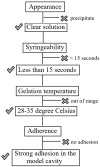Thermoresponsive sol-gel containing probiotic's cell free supernatant for dental caries prophylaxis
- PMID: 34992736
- PMCID: PMC8725760
- DOI: 10.1080/20002297.2021.2012390
Thermoresponsive sol-gel containing probiotic's cell free supernatant for dental caries prophylaxis
Abstract
Background: Lactobacillus rhamnosus SD11 is a probiotic derived from the human oral cavity and has potential being used for dental prophylaxis. The cell free supernatant (CFS) of L. rhamnosus SD11 has good antimicrobial and antioxidant effects.
Aim: This study aimed to incorporate CFS of the probiotic into thermoresponsive copolymers to create a sol-gel formulation.
Methods: The sol-gel formulation was developed using Poloxamer 407 as the main polymer, which was mixed with natural polymers such as gellan gum, sodium alginate, and xyloglucan in different proportions. The sol-gel formulations were characterized based on their physicochemical parameters such as appearance, pH, viscosity, flow-ability in low temperature, antioxidant and antibacterial activity. An in vitro release study was performed using Franz's diffusion cell and the stability was determined under freeze-thaw cycle conditions.
Results: The combination of 15% w/v of poloxamer 407 with 0.5% w/v of sodium alginate was the best sol-gel formulation to deliver the CFS of the probiotic.
Conclusion: This study was successful in creating a sol-gel formulation using a thermoresponsive copolymer, that could efficiently deliver CFS of the probiotic L. rhamnosus SD11.
Keywords: Cell free supernatant; Lactobacillus rhamnosus SD11; dental caries; poloxamer 407; thermoresponsive polymer.
© 2021 The Author(s). Published by Informa UK Limited, trading as Taylor & Francis Group.
Conflict of interest statement
No potential conflict of interest was reported by the author(s).
Figures










References
-
- Teanpaisan R, Piwat S, Dahlén G.. Inhibitory effect of oral Lactobacillus against oral pathogens. Lett Appl Microbiol. 2011;53(4):452–13. - PubMed
-
- Teanpaisan R, Srisommai P, Mapaisansin C, et al. Effect of probiotic delivery vehicles for probiotic Lactobacillus rhamnosus SD11 in caries prevention: a clinical study. J Food Process Preserv. 2019;43(10):1–6.
-
- Rungsri P, Akkarachaneeyakorn N, Wongsuwanlert M, et al. Effect of fermented milk containing Lactobacillus rhamnosus SD11 on oral microbiota of healthy volunteers: a randomized clinical trial. J Dairy Sci. 2017;100:7780–7787. - PubMed
-
- Wannun P, Piwat S, Teanpaisan R. Purification, characterization, and optimum conditions of Fermencin SD11, a bacteriocin produced by human orally Lactobacillus fermentum SD1. Appl Biochem Biotechnol. 2016;179:572–582. - PubMed
-
- Piwat S, Pahumanto N, Srisommai P, et al. Effect of probiotic delivery vehicles for probiotic Lactobacillus rhamnosus SD11 in caries prevention: a clinical study. J Food Process Preserv. 2019;00(e14147):1–6.
LinkOut - more resources
Full Text Sources
Molecular Biology Databases
